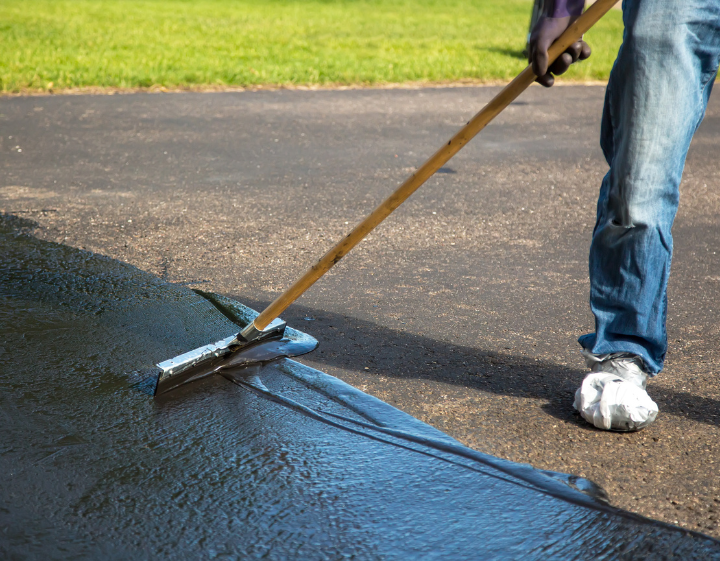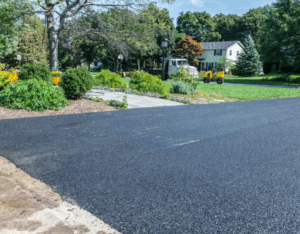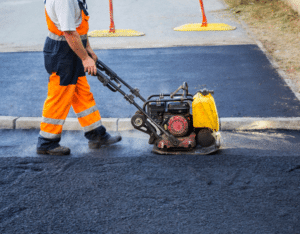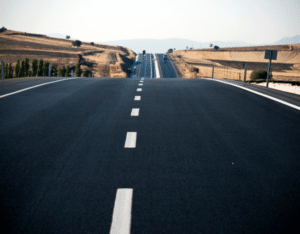Introduction
Seal coating is a crucial maintenance activity that helps to protect and extend the lifespan of pavement surfaces. By applying a protective coating to the surface, seal coating prevents damage from elements such as sunlight, water, and chemicals. While this is a commonly known aspect of seal coating, its role in enhancing safety is often overlooked.
Uncoated pavement surfaces can become hazardous, particularly in adverse weather conditions. The absence of a seal coat can lead to the formation of cracks, potholes, and other imperfections, making the surface uneven and dangerous for both pedestrians and vehicles. In wet weather, uncoated surfaces can become slippery, increasing the risk of accidents. Additionally, in cold climates, the freeze-thaw cycle can cause further damage to unsealed pavement, making it even more treacherous. By applying a seal coat to pavement surfaces, safety can be significantly enhanced. The seal coating fills in cracks and imperfections, creating a smoother and more even surface. This reduces tripping hazards for pedestrians and ensures better traction for vehicles, especially in adverse weather conditions. The seal coat also acts as a barrier against water infiltration, preventing the formation of potholes and reducing the risk of accidents caused by unstable pavement.
Seal coating not only protects and extends the lifespan of pavement surfaces but also plays a crucial role in enhancing safety. By understanding the less commonly discussed benefit of seal coating, both the practical and technical aspects of this maintenance activity can be better appreciated.
The Basics of Seal Coating
Seal coating is a protective process used to enhance the safety and longevity of pavements. It involves the application of a specially formulated liquid coating to the surface of the pavement. This coating acts as a protective layer, shielding the pavement from damage caused by water, sunlight, chemicals, and regular wear and tear.
The materials used in seal coating include asphalt emulsion, water, and various fillers. Asphalt emulsion is a mixture of asphalt cement, water, and an emulsifying agent. This liquid mixture is then combined with fillers, such as sand or finely crushed gravel, to improve durability and provide traction. The resulting blend is applied to the pavement in a controlled manner, forming a layer that bonds to the surface and fills in small cracks and imperfections. The application of seal coating involves a multi-step process. First, the pavement is cleaned and prepared, removing any dirt, debris, or vegetation. Then, the seal coating mixture is applied using a sprayer, squeegee, or brush, ensuring even coverage across the entire surface. It is typically recommended to apply two coats to achieve optimal protection.
Overall, seal coating serves as a cost-effective solution to extend the life of pavements by preventing damage from water, sunlight, and other factors. By providing a protective barrier, seal coating enhances safety by reducing the risk of potholes, cracks, and other hazards that can lead to accidents and injuries.
Safety Benefits of Seal Coating
Seal coating is a crucial maintenance activity that can significantly enhance pavement safety. By improving the texture of pavement surfaces and reducing water accumulation, seal coating provides numerous safety benefits for both vehicles and pedestrians.
One of the key safety benefits of seal coating is the enhancement of surface texture. Over time, the surface of pavement can become worn out and develop cracks and potholes, which pose a safety hazard for vehicles and pedestrians. Seal coating helps to restore the smoothness and integrity of the pavement surface, creating a better traction for vehicles. This improved surface texture reduces the risk of skidding, especially during wet or icy conditions, and enhances the overall safety for drivers.
Additionally, seal coating plays a vital role in reducing water accumulation on pavement surfaces. The application of seal coat creates a smooth and impermeable surface that prevents water from seeping into the pavement layers, thereby reducing the risk of hydroplaning. Hydroplaning occurs when water accumulates on a road surface, causing vehicles to lose traction and control. By minimizing water accumulation, seal coating helps to prevent hydroplaning accidents and increases the safety of the road.
Seal coating offers significant safety benefits by enhancing the surface texture of pavement and reducing water accumulation. By providing better traction for vehicles and minimizing the risk of hydroplaning, seal coating contributes to the overall safety of both drivers and pedestrians. Regular application of seal coating should be prioritized as part of a comprehensive pavement maintenance program to ensure safe and reliable transportation infrastructure.

Slip and Skid Resistance
Slip and skid resistance is a critical factor in pavement safety, and seal coating plays an important role in enhancing these properties. Seal coating is a protective layer that is applied to the surface of pavement, providing several benefits including improved skid resistance. The technical aspects of how seal coating enhances skid resistance involve the use of aggregate mixtures. These mixtures, which may consist of materials like sand, crushed stone, or other additives, are added to the seal coat to increase the surface roughness. By increasing the roughness of the pavement surface, seal coating helps to improve traction and minimize the risk of skidding or slipping.
In order to ensure optimal skid resistance, there are industry standards that dictate the recommended levels of friction for pavement surfaces. These standards often require certain values to be met for skid resistance, which can be achieved through the use of seal coating. Additionally, seal coatings undergo testing to ensure that they meet these standards. Various tests, such as the British Pendulum Test and the Locked Wheel Skid Tester, are commonly used to assess the skid resistance of seal coated surfaces and ensure they meet the desired safety requirements.
Seal coating plays a vital role in enhancing slip and skid resistance on pavements. By incorporating aggregate mixtures to increase surface roughness and adhering to industry standards, seal coatings help to maximize traction and minimize the risk of accidents caused by skidding or slipping.
Addressing Common Concerns
Seal coating is a popular method for enhancing pavement safety, but it is often met with common concerns. This section will address two specific concerns: the cost of applying seal coating and the potential environmental impacts.
When considering the cost of applying seal coating, it is important to compare it with the potential costs of accidents and liability from unsafe pavement conditions. Although seal coating does require an initial investment, it is significantly more cost-effective compared to the expenses incurred in the aftermath of accidents or lawsuits resulting from pavement-related incidents. By regularly applying seal coating, the lifespan of the pavement is extended, minimizing the need for costly repairs and replacements, thus saving money in the long run. Environmental concerns related to seal coating are also worth addressing. Critics argue that seal coating may release harmful materials into the environment. However, modern seal coating formulations have made substantial advancements in mitigating these concerns. Environmentally-friendly options now exist, which minimize the release of volatile organic compounds (VOCs) and other pollutants. Additionally, responsible application practices, such as proper waste disposal, can further reduce the environmental impact of seal coating.
Seal coating effectively addresses common concerns by considering both costs and potential environmental impacts. The cost of applying seal coating is outweighed by the potential expenses resulting from accidents and liability, making it a smart investment for pavement safety. With the advancements in modern formulations and responsible application practices, seal coating is becoming an environmentally-friendly maintenance activity. These considerations make seal coating a valuable tool for enhancing pavement safety while minimizing costs and environmental impacts.
Conclusion
Seal coating serves as a crucial tool for enhancing pavement safety. By providing a protective layer that shields the pavement from the damaging effects of UV rays, water, and chemicals, seal coating helps to prolong the lifespan of the pavement. This in turn reduces the likelihood of accidents and injuries caused by deteriorating and unsafe surfaces.
Furthermore, seal coating improves the visibility of pavement markings, making them more visible to drivers and pedestrians. This plays a significant role in preventing accidents and ensuring a safer environment for all road users. It is essential for property owners and municipal officials to recognize the importance of seal coating as a proactive safety measure. Regular maintenance and seal coating can save both money and lives in the long run. By investing in seal coating, property owners and local governments can ensure that their pavements remain in good condition, reducing the need for costly repairs or replacements in the future.
Seal coating is not only a practical and technical maintenance activity but a crucial safety measure for both private and public paved areas. By prioritizing seal coating, we can create safer environments for everyone, preventing accidents, and prolonging the lifespan of our pavements.



